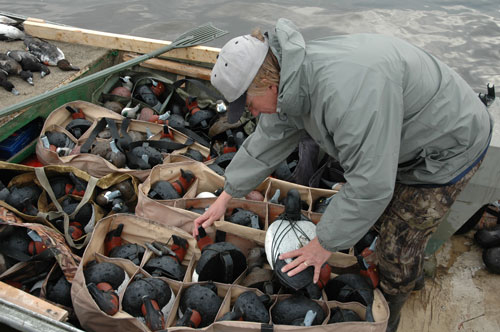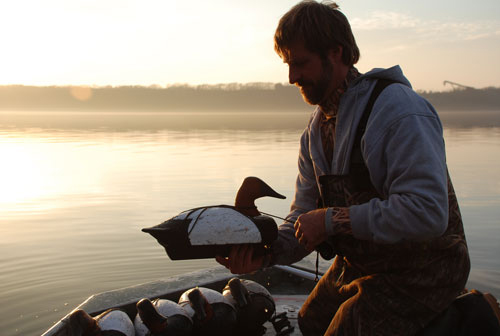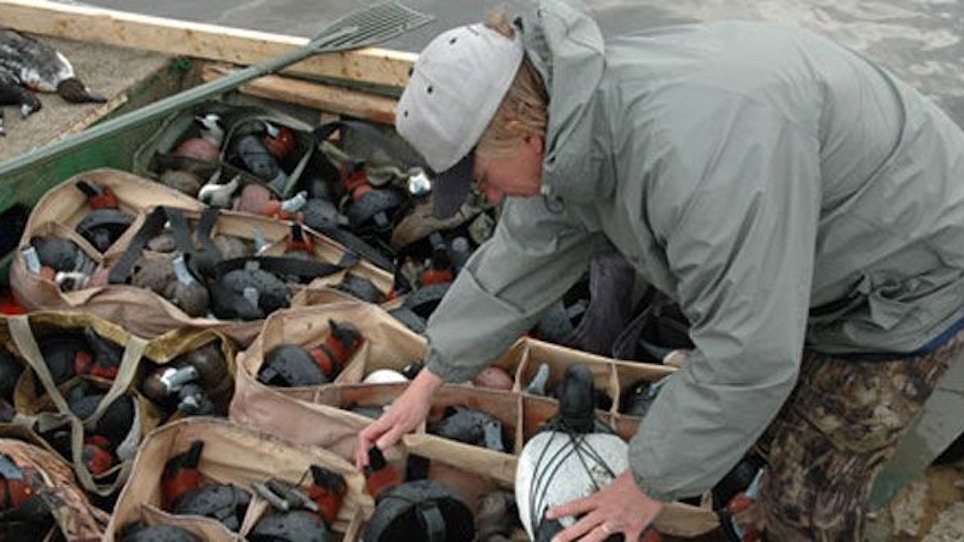 I killed my first duck — a one-legged hen mallard –— in the middle of Wolfe’s Swamp on an October evening in 1974. But it would be more than two and one-half decades, 26 years to be exact, before I would look down the rib and slap the trigger on one of the most memorable waterfowling experiences of my life, my first drake canvasback. And you want to know the best part? The scene was, without argument, as legendary to dedicated waterfowlers as Cooperstown is to anyone whoever donned a baggy Little League uniform. The place? The Mississippi River.
I killed my first duck — a one-legged hen mallard –— in the middle of Wolfe’s Swamp on an October evening in 1974. But it would be more than two and one-half decades, 26 years to be exact, before I would look down the rib and slap the trigger on one of the most memorable waterfowling experiences of my life, my first drake canvasback. And you want to know the best part? The scene was, without argument, as legendary to dedicated waterfowlers as Cooperstown is to anyone whoever donned a baggy Little League uniform. The place? The Mississippi River.
So how did a boy from Iowa end up with an audience not only with the Old Man, but the famed canvasback, too? Several years back, I had been given an assignment on big river divers; however, I wasn’t raised by a diver man. So I needed to find a diver man — one who knew not only divers, but more specifically, canvasbacks on the Mississippi River.
Enter Tony Toye of Big River Guide Service.
Monday, 30 October. That morning, four of us — Julie, myself, Toye, and his three-legged chocolate lab, Deacon had launched Toye’s sled near Ferryville, Wisconsin, and had made the run out to an incredibly natural-looking man-made island. After two attempts to conceal the big boat blind proved futile due to high winds and waves, Toye opted for a quieter location 200 yards to the west. Quickly, the guide maneuvered the boat onto the upstream point of a small island, and while Julie positioned what Toye called “witch’s brooms” — clumps of foxtail and other native grasses zip-tied around long dry posts — strategically around the boat, Toye and I began to set the decoys.
First, a “blob,” as the guide called it, of smaller canvasback decoys, 50 in all, were arranged upstream from the stern of the boat. This spread was continued with another 30 or so magnum canvasback blocks. A hole was left between the two groups to serve as a landing area. Puddle duck decoys, mallards with an old black duck or two thrown in, were set directly off the starboard side. Additional puddlers, along with four Canada goose floaters, were spread randomly off the bow. A couple padded seats, a little arranging of gear and calls, and we were open for business.
The first drake ‘can, one of a trio, fell to our host within 10 minutes of the opening bell. Two drake mallards and a gadwall later, I had my first drake canvasback. By noon, we’d seen several thousand ducks, including a beautiful flock of ‘cans that caught us all flat-footed, goldeneyes, buffleheads, and even one small group of sprig, and had added another pair of greenheads and a gorgeous grey duck to our bag.
Learnin’ The Mississippi River

“Location is key to targeting canvasbacks,” said Toye. “I mean, if you put out a big enough decoy spread, you can pick up a diver or two. But if you’re in the best spot with a huge decoy spread, it can be a case of ‘Don’t touch your gun barrel ’cause it’s too hot.’ It’s just all location.”
Location. That sounds elemental enough; however, when one considers Toye’s home pool on the Mississippi, Pool 9, runs more than 25 river miles and contains literally hundreds of thousands of publicly accessible waterfowling opportunities, the word location takes on an altogether different and potentially frustrating meaning. With that said, how then does Toye go about separating the good from the bad?
“We scout by truck,” he said. “We’ll just drive looking for a good group of ‘cans close enough to shore. There’s probably six or seven good miles along this side (Wisconsin) of the river that you can see well from the road. And the other side is all refuge, so it’s basically all or nothing along this side. The other thing is that you have to be in the exact spot where the birds were when you first saw them. That’s the spot where the birds are going to decoy.”
“The primary food for the ‘cans here on the pool is wild celery, with fingernail clams and zebra mussels next in line,” said Toye.
Pool 9 is one of the shallower pools on the Mississippi River, averaging from three to six feet in depth throughout all but the main shipping channel. And it’s true that ‘cans and other divers are fond of the wide-open spaces — “big water” — and any late October or early November drive along western Wisconsin’s Highway 35 will provide views of huge rafts of canvasbacks, tens of thousands of birds strong, balled up and riding the flow, all hundreds of yards from anything even remotely considered cover. This natural avian tendency, coupled with Wisconsin’s current open-water refuge law which requires waterfowlers on the Mississippi to hunt no more than 100 feet from the shore, an island, or any type of live, natural vegetation that provides at least partial concealment does serve a purpose, says Toye, that being the creation of a safe haven from which the birds, divers and puddlers alike, cannot be pushed.
Such species-specific characteristics and regulatory measures require hunters to improvise and adjust, hunting the open water from boats and blinds hidden among the cattails, switchgrass, cane, and blow-downs in much they same way they would a secluded backwater or inland slough. With, of course, one major exception. This slough is 25 miles long, a mile or more wide, and can, at the right time, hold more than a quarter of a million canvasbacks.
“My decoy spreads consist of about 120 floaters,” said the guide. “All magnum size. I use half mallards and half canvasbacks. On the side of the blind toward the open water, I’ll have what I call a big ‘blob’ of ‘cans. I’ll leave a 15- to 20-yard gap leading downwind, and then I’ll place a string of decoys. This looks like a small flock of ‘cans that have just landed and are swimming to join the larger group.
“On the other side, I’ll put a big bunch of feeding mallards. With the mallards, I’ll use a few pintails and other species, just for color. Same with the ‘cans. I’ll use a few bluebills and redheads off to the side.”
As a final tactical note, not only does Toye use magnum decoys in approximately one-half of his canvasback spread, he also uses only, as in 100 percent, drake ‘cans in his spread. His theory, and one which he’s proved year after year, is not only does size mean visibility on the big river, but the predominantly white drake ‘cans — like drake pintails in a puddle duck spread — attract attention from far, far away. And that’s important when you’re dealing with something as big as the Mississippi.
If You Go
Toye begins hunting in mid-October and continues through early December. Traditionally, the best time for canvasbacks is the last week in October and the first week in November, when more than 250,000 will raft on this section of the Upper Mississippi. While ‘cans provide the major draw for Toye’s clients, other ducks including mallards, blacks, widgeon, gadwall, teal, scaup, goldeneyes, redheads, and buffleheads are all on the menu.
For pricing, scheduling, or just enough story-telling to whet any waterfowler’s appetite, hunters can contact Toye at 608-375-7447 or 608-732-1221. He can also be reached electronically at toyedecoys@tds.net.






